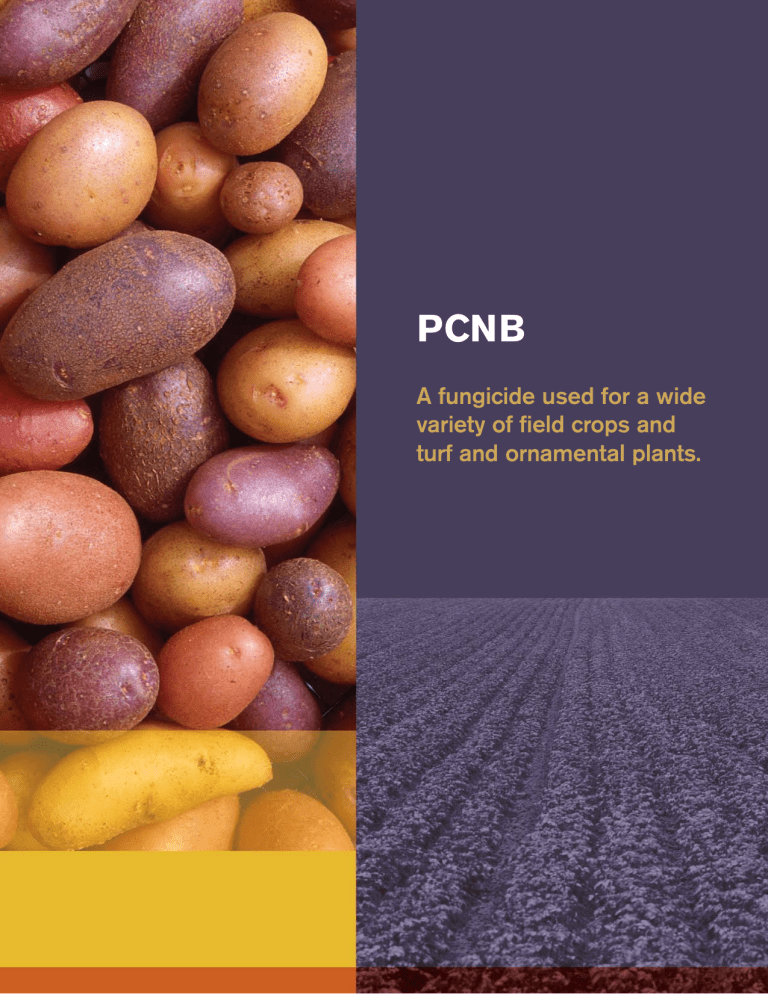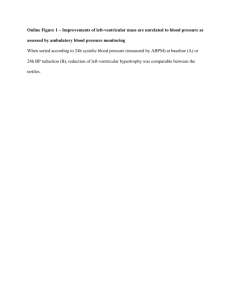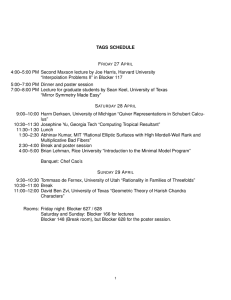A fungicide used for a wide variety of field crops and turf

PCNB
A fungicide used for a wide variety of field crops and turf and ornamental plants.
C
6
Cl
I5
NO
2
Pentachloronitrobenzene (PCNB)
PCNB is a broad spectrum, contact fungicide used for a wide variety of field crops and turf and ornamental plants, to control diseases caused by fungal pathogens.
PCNB
Pentachloronitrobenzene (PCNB) is a broad spectrum, contact fungicide used for disease control on a wide variety of field crops, as well as turf and ornamental plants, to control diseases caused by fungal pathogens.
It is primarily effective against soil-borne pathogens, but does display some efficacy against foliar diseases as well. Due to PCNB’s non-systemic nature, PCNB must be present on the plant or in the soil prior to the onset of infection to be effective.
PCNB has been registered for use since the mid-
1950’s. PCNB fungicide is sold under the Blocker™ and Par-Flo ® trademarks in various formulations by
AMVAC Chemical Corporation. PCNB is a versatile product and may be applied by several methods including transplant solutions, row drench, in-furrow at planting and in foliar sprays.
It is also commonly used as a seed treatment fungicide. In-furrow banded treatment at planting is the most common method of application on the crops registered.
Features and benefits
PCNB controls or suppresses a wide range of plant diseases. It is a contact fungicide with multisite activity. PCNB forms a protective zone around plant roots and stems, thus protecting them from disease development.
Diseases controlled or suppressed
Clubroot (Plasmodiophora brassicae)
Wire Stem or Black Rot (Corticium solani)
Root/Stem Rot /Stem Canker/Black Scurf
(Rhizoctonia solani)
White Mold (Sclerotinia sclerotiorum)
White Rot (Sclerotium cepivorum)
Southern Blight (Sclerotium rolfsii)
Anthracnose/Black Dot (Colletotrichum coccodes)
Common Scab (Streptomyces scabies)
Gray Snow Mold (Typhula spp.)
Pink Snow Mold (Microdecum nivali)
Leaf Spot (Drechslera spp.)
PCNB products are registered on many crops
Beans (dry, snap or succulent)
Broccoli
Brussels Sprouts
Cabbage
Cauliflower
Chinese Broccoli
Chinese Cabbage (tight-headed varieties only)
Collards
Cotton
Garlic
Kale
Mustard Greens
Peanuts
Peppers
Potatoes
Tomatoes
Formulations
PCNB is available in several convenient formulations to fit your specific needs. Both
Blocker™ and Par-Flo ® are available in 4 lb. per gallon flowable and 10% granular formulations.
PCNB is also available as a 75% wettable powder formulation, primarily for turf and ornamental uses.
Use rates and guidelines
PCNB use rates range from 0.75 to 5 lbs. active ingredient per acre depending on crop and application method. Turf rates range from 0.5 to
0.75 lbs. active ingredient/1000 sq. ft. and transplant solution rates range from 0.75 to 3.75
lbs. active ingredient per 100 gallons of water.
PCNB is an excellent tank mix partner with other popular crop, turf and ornamental protection fungicides. It is the foundation or base for disease control in these applications. It is most often tankmixed or used sequentially with other approved fungicides to increase efficacy and to decrease resistance development of single-site mode of action products.
TOXICOLOGICAL INFORMATION
Summary of acute and chronic toxicity data for terrestrial organisms
Species LD
50
(ppm)
Acute
Oral
Toxicity
5-Day
LC
50
(ppm)
Subacute
Dietary
Toxicity
Chronic Affected
Toxicity Endpoints
NOEC*/LOEC**
(ppm)
Northern >2250 Practically >5620 Practically 600 / 1200 reproduction quail
Mallard — — >5620 Practically duck non-toxic
600 / 1200 growth
— — bee
Laboratory rat
(mg/bee contact)
>5050
(mg/kg) non-toxic
Practically non-toxic
— — 10 / 100 —
* No Observed Effect Concentration
** Lowest Observed Effect Concentration
Summary of acute and chronic aquatic toxicity
Species
Rainbow trout sunfish
Sheepshead minnow
96-hr
LC
50
(mg/L)
0.32
7.9
Acute
Toxicity highly toxic
Affected
Endpoints highly — moderately toxic
Chronic
Toxicity
NOEC/LOEC
((m /L
0.013 / 0.032
0.027 / 0.054
growth growth
— oyster toxic
Mysid shrimp
0.012
very highly toxic
— —
Common Scab in Potatoes Rhizoctonia Black Scurf Pink Snow Mold in turf Rhizoctonia Stem Canker
Mode of action
PCNB is listed as a lipid and membrane synthesis inhibitor with the Fungicide Resistance
Action Committee.
• PCNB breaks down into CO
2
, which inhibits the uptake of oxygen by the disease spore and either kills the fungus or prevents it from germinating by blocking the metabolic pathway (anti-sporulation).
• PCNB also interrupts the metabolic pathway of a soil-borne pathogen by blocking the pentose phosphate shunt, the entry of pyruvic acid into the Krebs cycle, and glucose formation in general.
Due to multi-site modes of action, no known resistance by any pathogen to PCNB has been documented.
Chemical and physical properties
Appearance Crystals from alcohol; colorless needles; fine needles from alcohol, platelet from carbon disulfide
Chemical Name Pentachloronitrobenzene
CAS Number 82 68 8
Molecular Weight 295.36
Molecular Formula C
6
Cl l5
NO
2
Water Solubility Approximately 0.4 ppm
Melting Point 142º–145º C
Half-Life in Water 1.8 days
Half-Life in Soils Approximately 80 days
Toxicological information
PCNB has low acute toxicity with study results placing PCNB in Toxicity Categories III or IV (Signal
Word CAUTION), although one study has identified
PCNB as a weak skin sensitizer. Subchronic and chronic studies indicate that the thyroid and liver are the target organs for PCNB toxicity. Increases in the thyroid stimulating hormone (TSH) and thyroid and liver hypertrophy suggest that the thyroid effects may be due in part to a disturbance of thyroid homeostasis. PCNB has generated thyroid tumors in the rat via this mechanism in a two year study and therefore has been classified as a Group C — possible human carcinogen. There is however no evidence of genotoxic potential from a range of in-vivo and in-vitro studies that have been carried out. PCNB does not cause reproductive, teratogenic or developmental effects in rats or rabbits. In addition, there is no indication of any neurotoxicological effects from the extensive toxicological database of studies that have been performed.
PCNB for disease control in potatoes
PCNB products are the base for many soil-borne and foliar disease control programs in potatoes.
PCNB use labels for potatoes have been expanded over the last several years to allow use of this valuable tool in a variety of potato applications.
The in-furrow application label for Blocker was recently expanded to add suppression of common scab and black dot to the existing Rhizoctonia control label. Additionally, Blocker may be tankmixed with other registered fungicides and applied via chemigation to suppress white mold
(Sclerotinia sclerotiorum) and black dot (Colletotrichum coccodes) in potatoes grown in the Pacific
Northwest under Special Local Need Registrations.
The Effect of Blocker 4F on Potato Stems and Stolons Infected with Rhizoctonia Solani
Colorado State University, 2001
25
20
15
10
45
40
35
30
5
0
Control
Blocker 4F
5.0 lbs. ai/A
Moncut™ 50 W +
Blocker 4F
0.5 + 2.5 lbs. ai/A
% Stems with
Rhizoctonia
% Stolons with
Rhizoctonia
PCNB is considered a “standard” treatment for controlling
Rhizoctonia solani in many crops. It is most often used as the
“base” treatment in conjunction with seed treatments and/or other fungicides for controlling Rhizoctonia and other soil and seed-borne pathogens. The above graph displays the effectiveness of Blocker 4F alone in controlling Rhizoctonia solani on potato stems and stolons, and also displays the flexibility and added efficacy of the product when used in combination with other registered products.
The Effect of Blocker 4F on Snowden Potato
Tubers Infected with Common Scab
Stevens Point, WI, 2001
100
90
80
70
60
50
40
30
20
10
0
Control
Blocker 4F
2.5 lbs. ai/A
Blocker 4F
3.75 lbs. ai/A
Blocker 4F
5.0 lbs. ai/A
% Tubers without scab
% Tubers with severe scab
Blocker 4F also displays excellent suppression of common scab infection on potato tubers and greatly reduces the severity of scab on the tubers as displayed above.
PCNB Provides Consistent Control of Snow Mold
Michigan State University
PCNB +
Chlorothalonil
+ Iprodione
PCNB +
Chlorothalonil
2002
2001
2000
1999
2
0
6
4
The Effect of Blocker 4F on Snowden Potato
Stems Severely Infected with Rhizoctonia Solani
Stevens Point, WI, 2001
14
Control
12
10
8
Blocker 4F
2.5 lbs. ai/A
Blocker 4F
3.75 lbs. ai/A
Blocker 4F
5.0 lbs. ai/A
% Stems Severely Infected with Rhizoctonia
The above data display the diversity in use rates of Blocker 4F for decreasing the severity of Rhizoctonia infection on potato stems.
PCNB
0 25 50 75 100
% Snow Mold Control
PCNB products are the cornerstone for snow mold control in turf.
PCNB products have been tested for over 50 years by university and private researchers and consistently rank at or near the top in those studies. PCNB must be applied in the fall, before snow mold symptoms appear and before the snow cover begins. The product controls both grey (Typhula spp.) and pink (Microdecum nivale) snow mold. Combining PCNB with other active ingredients has been documented to provide enhanced snow mold protection, and no snow mold resistance to PCNB has been documented during that extended period.
In Michigan State University turf trials over four years (above),
PCNB alone displayed good control of snow mold, but improved control was noted when combinations with other products were utilized. The increase in efficacy is important, but combinations of fungicides also decrease the potential for resistance development of any pathogen to any group of fungicides. Furthermore, even the highest recommended use rates of PCNB on turf will not harm beneficial mycorrhizae.
PAR-FLO
®
4F
For more information about PCNB, contact your local agricultural chemical retailer, call 1-888 GO AMVAC
(1-888-462-6822) or visit www.amvac-chemical.com.
Photo of potato field courtesy of James Luzader, USDA NRCS
Always read and follow all label directions and use precautions. Always pre-test for phytotoxicity prior to large-scale use.
Blocker™ and Par-Flo ® are trademarks of AMVAC Chemical Corporation and Moncut™ is a trademark of Gowan Company.
© 2006 AMVAC Chemical Corporation. PCNBAMPC002-2006

